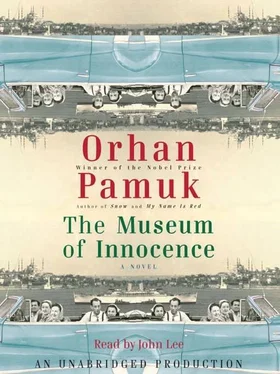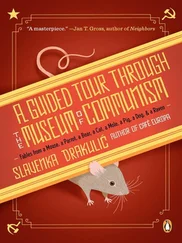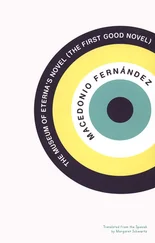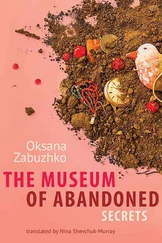Here I display a model of Füsun’s apartment in Çukurcuma (this being the second floor of the building as a whole), which will, I hope, serve as an introduction to the eight-year span of my story. On the floor above the living room was the bedroom that Aunt Nesibe shared with Tarık Bey, and the one Füsun shared with her husband; between them was a bathroom.
A close look at the model will reveal that my place at the dinner table is marked. For those unable to visit our museum, let me explain: I sat across from the television, which was slightly to my left, and with the kitchen just to my right. Behind me was a sideboard, and sometimes, if I tipped back my chair, I would knock against it. Then the crystal glasses inside would shudder along with the porcelain and the silver sugar bowls, the liqueur sets, the never-used coffee cups, the old clock, the silver lighter that no longer worked, the little glass vase with the spiraling floral pattern whose likeness one could see displayed on the buffet of any middle-class family in the city, other assorted ornamental pieces, and finally the buffet’s glass shelves.
Like everyone else at the table, I sat watching television year in and year out, but casting my eyes slightly to my left, I could see Füsun quite well without needing to turn toward her or move in the least. This meant that while I was watching television I was able to look at Füsun for extended periods without anyone noticing, simply by moving my eyes. The temptation was, of course, irresistible, and the more I performed this feat, the more expert I became at it.
If we were watching a film that had reached its climax, or some news story that we found particularly gripping, I took great pleasure in tracking Füsun’s expressions; in the subsequent days and months my memory of the images on the screen would merge with that of the expression on her face. Sometimes at home I would first recall Füsun’s expression before the affecting scene that had provoked it (an indication that I missed Füsun and had gone too long without coming to supper). The deepest, strangest, and most stirring memories of scenes watched during the eight years at the Keskins’ dinner table are indelibly marked with corresponding images of Füsun. My fluency at reading her expressions reached the point where I could look at her from the corner of my eye and deduce with remarkable accuracy what was happening on television, even if I had been paying no attention to the screen.
On the table, next to the place where Aunt Nesibe would come to sit later in the evening, after the food was served, there was a lamp with clawed feet and a shade that was always askew, and next to it was an L-shaped divan. Some evenings, if the eating, drinking, laughing, and talking had proved particularly exhausting, Aunt Nesibe would say, “Come on, everyone, let’s sit on the divan,” or “Go relax and I’ll bring you coffee!” and then I would sit on the end of the divan closest to the sideboard, while Aunt Nesibe sat on the other end, and Tarık Bey took his place next to the bay windows, on the chair closest to the hill. For a good view of the screen from our new places, it was necessary to pivot the television set, and this Füsun would do, from her place at the table, where she would remain. Although sometimes, having changed the angle of the television, she would take a seat at the far end of the divan, beside her mother, the two nestling together as they watched. Sometimes Aunt Nesibe would stroke her daughter’s hair and her back, and, like Lemon the canary, who would be watching us with interest from his cage, I took great pleasure in the spectacle through the corner of my eye.
Late at night, when I had sunk into the cushions on the L-shaped divan, the raki I had drunk with Tarık Bey would make itself felt, and I could almost drop off to sleep, watching the television screen with one eye open, and with the other it was as if I were looking into the depths of my soul; I would feel the shame I had at other times succeeded in banishing, the shame that life had brought me to such a strange place, and an anger would well up urging me to get on my feet and leave the house. It was not uncommon for me to feel this way on those dark, dire nights when Füsun’s expressions had displeased me, when she had offered hardly a smile, and even less if I brushed against her, intending nothing, but having done so, requiring a sign of assurance.
At such moments I would stand up and go to the bay window, where Lemon the canary was slowly aging in his cage, and I would peek through the curtains over the middle or right-hand panes at Çukurcuma Hill. On wet days you could see the light of the streetlamps reflected on the cobblestones. Without taking their eyes off the screen, Aunt Nesibe and Tarık Bey would be prompted to say: “Has he eaten his food?” “Shall we change his water?” “He’s not very happy today.”
There was one more room on the first floor; it was at the back and had a narrow balcony. Used mostly in the daytime, it was where Aunt Nesibe did her sewing and Tarık Bey read his newspaper. After the first six months, whenever I felt uncomfortable at the table, perhaps wanting to pace nervously for a while, I would often go into this room if the light was on, to look through the balcony window: I enjoyed standing there surrounded by the sewing machine, the shears, the old newspapers and magazines, the open drawer with an array of ornaments, and before leaving I would often pocket something to soothe me later on if I was pining for Füsun.
Through this balcony window I could see a reflection of the room in which we were eating overlaying the prospect of a row of destitute houses in the narrow lane behind the house. On a few nights I spent a long time watching a woman who lived in one of these houses. Every night it was her habit, after putting on her woolen nightdress and before going to sleep, to take one pill from a box of medicine, and with it the crumpled instructions, which she would read with great care. It was only when Füsun came to stand beside me in the back room one night that I realized this was the widow of Rahmi Efendi, the man with the artificial hand who had worked in my father’s factory for so many years.
Füsun whispered that she had followed me into the room to find out what I was up to back there. Her casual curiosity moved me, and for a time we stood together in the dark, side-by-side at the window, looking out at the street. At that moment I came close to grasping what it was that kept me coming to the Keskin house for eight years: I was driven by the very question that lay at the heart of what it meant to be a man or a woman in our part of the world.
In my view, Füsun left the table that evening because she wanted to be close to me. This was clear from the way she stood by me in silence, gazing at what was to her a very ordinary view. But for me, as I cast my eyes upon the roof tiles, and the tin roofs, and the smoke puffing gently from the chimneys, as I peered through lit windows, catching glimpses of families moving about their homes-it all seemed extraordinarily poetic, simply because Füsun was at my side, and the desire was great to put my hand on her shoulder, to wrap my arms around her, or just to touch her.
But my experience at the Çukurcuma house during the first weeks was enough for me to tell that Füsun’s response would be severe, perhaps even as cold as if I had tried to molest her; she would push me away and leave the room abruptly, causing extravagant pain, and launching us into our twinned indignation (the game that we would slowly perfect over the years) with the ultimate result that for a time I would not even go to the Keskins’ for supper. Even having reasoned this through, the urge to touch her, kiss her, or, at the least, brush against her side persisted. The raki played some part in this. But even if I’d had nothing to drink, this dilemma would have afflicted me nonetheless.
Читать дальше
